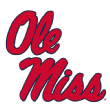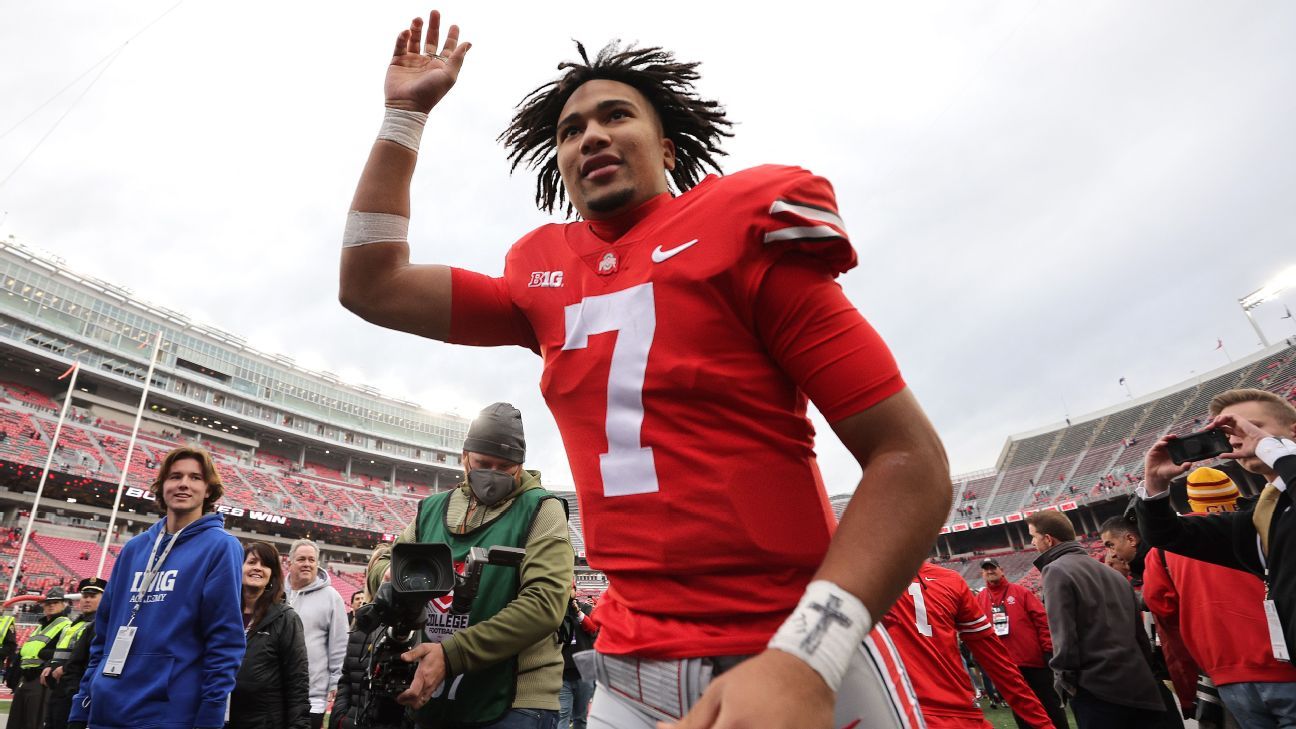The Heisman Trophy will be awarded in less than three weeks, and no one has run away with it.
A quarterback has won the award in four of the past five years, nine of the past 11 years and 12 of the past 15 years. A defensive player hasn’t won the award since 1997.
Maybe this year is different. Georgia defensive tackle Jordan Davis and Alabama linebacker Will Anderson Jr. have stood out on defense with stellar seasons of their own. Michigan State running back Kenneth Walker III turned in a legendary five-touchdown performance against rival Michigan.
Or maybe this year won’t be an anomaly. Ohio State quarterback C.J. Stroud and Alabama QB Bryce Young went from reserves for College Football Playoff teams in 2020 to bona fide stars in 2021. Pittsburgh’s Kenny Pickett, in his fifth season of eligibility, has thrown for nearly as many touchdowns this year (36) as he had from 2017 to 2020 combined (39). Ole Miss QB Matt Corral helped take the Rebels from unranked before the season to the top 10 of the AP poll entering Thanksgiving.
Before the season, Oklahoma’s Spencer Rattler and North Carolina’s Sam Howell — both quarterbacks — were among the favorites to win college football’s prestigious award. But neither of them is in the conversation this year.
Our team of reporters break down the cases for — and the cases against — each Heisman contender this year.

The case for: Is this even a question after the Michigan State game? Stroud set a team record with 17 consecutive completions and had 294 passing yards and four touchdowns in less than 20 minutes. He finished with 432 passing yards and six touchdowns, while not playing in the fourth quarter.
The Heisman should be about a player’s evolution, and no candidate has improved more since the start of the season. Stroud had the difficult task of replacing record-setting quarterback Justin Fields, and he didn’t have the benefit of playing time in 2020 because of the condensed Big Ten season. He hadn’t attempted a pass in college before Sept. 2.
Stroud had some shaky moments early on, but after missing a game with a throwing shoulder injury, the redshirt freshman from California has surged. In only 10 games, Stroud has completed 71% of his passes for 3,468 yards with 36 touchdowns and only five interceptions on 346 attempts.
The case against: Although Stroud has turned it on lately, other candidates such as Young, Matt Corral and Walker have been exceptional from the start. Stroud also benefits from playing behind arguably the nation’s best offensive line and throwing to undeniably the nation’s best wide receiving corps.
Many quarterbacks likely would put up big numbers when throwing to wide receivers Chris Olave, Garrett Wilson, Jaxon Smith-Njigba, tight end Jeremy Ruckert and others. Stroud also didn’t light up two of the better Big Ten defenses he faced in Penn State and Nebraska, two games Ohio State largely won because of its own defense.
But the big thing working against Stroud is his supporting cast, which includes freshman running back TreVeyon Henderson. Other top Heisman candidates have been the reason why their team wins, not just one of the reasons. Some might argue Olave is Ohio State’s best player, not Stroud. — Adam Rittenberg

The case for: It’s funny how quickly things can change. For much of the first decade of Nick Saban’s tenure at Alabama, his quarterbacks were often labeled game managers who couldn’t catch a whiff of the Heisman conversation. Then along came Jalen Hurts, Tua Tagovailoa and Mac Jones, and everything changed. Now, we’ve become so accustomed to stars at the position that what Young has done this season is almost being taken for granted.
Remember, we’re talking about a first-time starter, a sophomore who saw very limited action last season backing up Jones, and in his first career start, at a neutral site against a then 14th-ranked Miami team, Young threw for 344 yards, four touchdowns and no interceptions. All he has done since then is lead his team to playoff contention and the No. 2 ranking while completing 71.7% of his passes for an eye-popping 3,584 yards, 38 touchdowns and only three interceptions.
Oh, and that’s to say nothing of Young’s ability to run the football, which we’ve started to see more of in recent weeks. He does so sparingly — he’s a passer first and foremost — but he has proved to be elusive in the open field. Removing sacks, since Oct. 6, he has run for 140 yards and two touchdowns on just 23 carries.
The case against: There are essentially two elements that could keep Young from more serious Heisman contention, the first being the lack of a showcase game a la Walker against Michigan or Stroud against Michigan State. Remember, Alabama hasn’t faced a top-10 team all season. The closest was No. 11 Florida, but that was Week 3 and the Gators have circled the drain since then. Young’s best chance to have a statement performance will be in the SEC championship game against No. 1 Georgia, but that’s a tough ask against what appears to be an all-time defense, never mind the difficulty of influencing voters that late in the process.
Second, and maybe most important to the case against Young, is that he might not even be the best player on his own team. Outside linebacker Anderson has been arguably the most dominant player in every game Alabama has played this season, racking up 13.5 sacks and 26.5 tackles for loss. Heck, even receiver and return specialist Jameson Williams has had games in which he has shined brightest. The Ohio State transfer has been one of the best deep threats in the country, catching 59 passes for 1,218 yards and 13 touchdowns. He has also returned two kickoffs for touchdowns. — Alex Scarborough

The case for: Let’s start with the most obvious thing about Georgia’s senior nose tackle. He’s an absolutely enormous human being. Check out this photo of him standing next to teammate Devonte Wyatt. It’s unreal. And that size has had a massive impact on Georgia’s defense this season. Davis eats up gaps like he eats Swedish Fish (side note: Davis loves Swedish Fish), and the Bulldogs are allowing less than a yard before contact on runs up the middle as a result.
The man in the middle is 6’3″ 315lb Devonte Wyatt
The man on the left is Jordan Davis
(Via @sarahg1561) pic.twitter.com/GIUhuOndl8
— PFF College Football (@PFF_College) November 20, 2021
It’s not just the size that matters here. Davis has extraordinary physical skills, too. He runs like a man half his size, as demonstrated by the 360-pound Davis chasing down 215-pound UAB QB Tyler Johnston III from behind on a scramble earlier this season. South Carolina coach Shane Beamer called it one of the most impressive things he’s ever seen on a football field, and he’s not wrong. Heck, Davis has even gotten in on offense this season, scoring a rushing TD against Charleston Southern in the process.
While Davis’ stat line won’t wow any casual observer (23 tackles, two sacks), his job isn’t about his personal box score. He’s playing the ultimate team role this season, and the real evidence of his greatness shows up only when you zoom out to see his impact on the team as a whole. Against FBS foes, Georgia is allowing just 3.4 yards per play, allows an explosive play just once every 22 snaps, and allows successful plays on first or second down just 34% of the time when Davis is on the field. Compare that to arguably the best defense in the past 25 years, 2011 Alabama, and the numbers hold up well (3.1 yards per play, one explosive play for every 20 snaps, 36% success rate on first and second down).
For too long, the Heisman has been a nearly exclusively offensive award — and typically one reserved for quarterbacks. It’s time things changed, and Davis has turned in a season more than deserving of the honor. At the end of the day, he’s the best player on the best unit for the best team in the country. That’s a Heisman pitch if ever there was one.
The case against: Davis has three big things working against him in his quest to win the Heisman hardware.
The first is history. Charles Woodson is the only defensive player to win the Heisman, back in 1997, and he also starred on special teams. There simply isn’t much of a track record of defensive linemen making a real push, and even when they do — like Nebraska’s Ndamukong Suh, who finished fourth in 2009 — there are usually some gaudy stats to state their case.
That leads us to problem No. 2: the stat line. Davis just doesn’t have the numbers, and voters like numbers. To appreciate Davis’ brilliance is to appreciate why Mozart is better than Creed. You can’t go by record sales. The difference is ephemeral, even if it’s obvious to anyone with good taste. Davis is a team-first player in the ultimate team sport, but that rarely helps when it comes to individual awards.
It also speaks to Davis’ third problem. He’s on a genuinely great defense filled with genuinely great players. Linebacker Nakobe Dean could easily be in the Heisman conversation, too. Kelee Ringo, Derion Kendrick and even Davis’ backup, Jalen Carter, have all been exceptional this season, too. So can voters really be expected to discern between Davis’ impact and the guy who typically replaces him on third down and has racked up more sacks, tackles for loss and QB hurries?
Truth is, Davis is the Heisman candidate for a refined audience, but there’s not exactly a rich history of voters digging that deep into defensive schemes. — David Hale

The case for: Through 11 games, Walker is second in total rushing yards with 1,498 and tied for fourth in rushing touchdowns with 17. What really speaks to Walker’s ability and the work that he has done this season is the fact that he leads all FBS rushers in evaded tackles with 49, he’s fourth in broken tackles, tied for first in missed tackles this season and is first in rushing yards after first contact with 923 yards. That shows that Walker has created a lot of his own yardage and has had to make defenders miss in order to get some tough yards.
The Spartans ranked 123rd in rushing yards per game last season, averaging only 91.4 yards without Walker on the team. This season, Michigan State is averaging over double its 2020 production with 185.8 yards per game. Walker has revitalized the ground game for Michigan State and has been a big reason the team has only two losses. Without his five rushing touchdowns against rival Michigan, the Wolverines come away with the win in that game.
The case against: Walker has had some big performances, including the season opener against Northwestern, when he ran for 264 yards and four touchdowns. His five touchdowns against the Wolverines was another standout performance, but he has also had games in which he hasn’t been a factor.
Nebraska held him to just 61 yards and no touchdowns on 19 attempts. Indiana held him to 84 yards on 23 attempts. And in one of the biggest games of the season against Ohio State, the Buckeyes held Walker to just 25 yards on six attempts. Part of his lack of carries against the Buckeyes was because the offense needed to find ways to score quickly, but when he did run the ball, there was no room to move.
That performance came opposite fellow Heisman contender Stroud, who put up giant numbers for the Buckeyes to help his Heisman campaign. That was a closely watched matchup and Stroud came away with the recognition. — Tom VanHaaren

The case for: The Heisman Trophy is supposed to “epitomize great ability combined with diligence, perseverance, and hard work.” Anderson fits into that mold perfectly as a true sophomore who has not only improved as a player, but developed into one of the country’s most feared pass-rushers. It’s rare for a truly great team to not have a Will Anderson Jr. on their squad.
Anderson is tied for the FBS lead in sacks at 13.5, and he has the most solo sacks in the nation at 13. Alabama’s defense, which is eighth in the country in yards per game allowed, didn’t have one person who stood out as a clear-cut leader of that unit, but it has become Anderson.
Heisman Trophy winners stand out not just because of the eye-popping numbers that they put up (as Anderson has), but also because of their dominance. Anderson has undoubtedly been one of the most consistently dominant forces in the country all season, on one of the best teams in the country. There’s also no question that the Tide’s defense wouldn’t look the same without him.
The case against: While Anderson is one of the most feared pass rushers in the country, he hasn’t had a performance that left the nation in awe. Yes, he had four sacks on the road at Mississippi State, which is no small task. But it would have held more weight had he done such a thing at Texas A&M (a game in which he had six total tackles and no sacks).
Some could also argue that Anderson might not be the best player on his team with fellow Heisman candidate Bryce Young at quarterback, a position that’s much more inclined to receive attention — both good and bad. For Young, it has been all good, as Alex Scarborough noted above.
Take Young out of the equation, and the case against Anderson is not even necessarily a “case” against him, but rather the history of the award and how many people view the game. Players who aren’t quarterbacks and running backs have to be historically great to win the Heisman trophy — it’s why it took so long for people to come around on DeVonta Smith last season. — Harry Lyles Jr.

The case for: Pickett has shattered just about every school record in his historic season — including the career passing yards mark and single-season passing yards and touchdowns marks. As it stands, Pickett ranks No. 3 in the nation in total offense (370.4 yards per game), No. 5 in passing yards 3,857, No. 5 in points responsible for and No. 8 in passing efficiency and is the favorite to win ACC Player of the Year honors.
Just as importantly, he has led Pitt to the ACC championship game with his leadership, resilience and poise, and he has done it on a team that does not have the plethora of five-star recruits that Alabama and Ohio State rotate into the program year after year. He does not play in a gimmicky offense, either, that gives him outsized opportunities to rack up eye-popping numbers.
What Pickett has done is perfect what has been asked of him in the pro-style offense as a fifth-year senior. One NFL scout said recently no player has done more to improve his draft stock than Pickett. Pitt coach Pat Narduzzi spells out the case for Pickett quite emphatically.
“He’s not just a guy with the arm, which he’s got,” he said. “He’s got the elusiveness and athletic ability to scramble, and he’s got the leadership skills. He’s going to be the best quarterback in this class in the NFL.”
The case against: Pickett is being asked to shoulder the entire offense in a pass-first approach, and that has led to a few untimely mistakes — including several multiple-interception games. His efficiency in his past two games against Virginia and North Carolina has also dropped just a tad, but those are minor nitpicks.
The bigger issue might be that Pitt has no wins over ranked teams. Its best win is over Clemson, which should count as a top-tier victory, but the Tigers are not anywhere near their usual elite status. The other contenders on this list play in conferences that have better reputations — well deserved or not — or have more opportunities to play on bigger national stages.
Pickett willed his team to win against Virginia on Saturday, but how many people across the country tuned in to watch when Alabama was playing at the same time? Pickett should be judged on his merits, but often that is not the reality for players outside the playoff contenders. — Andrea Adelson

The case for: Corral has been the heart and soul of an Ole Miss team that has a chance to win 10 games in the regular season for the first time in school history. He hasn’t been healthy for the last half of the season, but he has gutted it out to stay on the field and lead an Ole Miss offense that is ranked 18th nationally in scoring (36.4 points per game). That’s despite two of his best receivers battling injuries.
The 6-2, 200-pound Corral plays the quarterback position like a linebacker and is the only FBS player with more than 3,000 passing yards (3,100) and more than 500 rushing yards (552). Never was his toughness more on display than the 31-26 road win over Tennessee in which he rushed 30 times for 195 yards and also passed for 231 yards and two touchdowns. One of the best things Corral has done this season is not turn the ball over. He has thrown only three interceptions.
The case against: Corral hasn’t been quite as prolific in the passing game the past month, but much of that is because he hasn’t been 100% healthy. It also didn’t help that Ole Miss was blown out by Alabama on the Rebels’ biggest stage of the season, and Corral was held to 213 passing yards in that game.
The conference championship weekend can also play a big role in the way people vote, and the Rebels won’t be playing that final weekend before ballots are cast. — Chris Low
